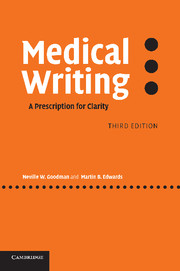Book contents
- Frontmatter
- Contents
- Preface to the first edition
- Preface to the third edition
- Acknowledgements
- PART I PROBLEM: THE ILLNESS
- PART II SOLUTION: SYMPTOMATIC RELIEF
- 3 Guidelines to clearer writing
- 4 Is there a better word?
- 5 Superfluous words
- 6 Imprecise words and phrases
- 7 Superfluous phrases
- 8 Trouble with short words
- 9 Use of the passive voice
- 10 Consistency: number and tenses
- 11 Circumlocution, metaphor and cliché
- 12 Word order and pronouns
- 13 Punctuation
- 14 Constructing sentences
- 15 Drawing clear graphs
- PART III PRACTICE: RECUPERATION
- Appendix: examples to rewrite
- References and further reading
- Index
14 - Constructing sentences
Published online by Cambridge University Press: 23 November 2009
- Frontmatter
- Contents
- Preface to the first edition
- Preface to the third edition
- Acknowledgements
- PART I PROBLEM: THE ILLNESS
- PART II SOLUTION: SYMPTOMATIC RELIEF
- 3 Guidelines to clearer writing
- 4 Is there a better word?
- 5 Superfluous words
- 6 Imprecise words and phrases
- 7 Superfluous phrases
- 8 Trouble with short words
- 9 Use of the passive voice
- 10 Consistency: number and tenses
- 11 Circumlocution, metaphor and cliché
- 12 Word order and pronouns
- 13 Punctuation
- 14 Constructing sentences
- 15 Drawing clear graphs
- PART III PRACTICE: RECUPERATION
- Appendix: examples to rewrite
- References and further reading
- Index
Summary
Balance
The most important grammatical guide to the construction of sentences is that segments should have equal value. A segment of a sentence may be a phrase or a clause. A phrase is defined as a segment without a finite verb, so a word can be considered a short phrase. Segments are divided by punctuation and joined by conjunctions. The simplest conjunction is and.
The word BOTH allows a good illustration of what is meant by segments of equal value.
Ewing's sarcoma occurs both in flat bones and in long bones.
The two phrases that follow both (joined by and) each contain a preposition (in), an adjective (flat, long) and a noun (bones). The two phrases do not have to be the same length (in children's growing flat bones has the same value), but balance is lost if one segment contains a finite verb:
Ewing's sarcoma both occurs in flat bones and in long bones.
Here both governs a finite verb (occurs) in the first segment (which is now a clause), and the lack of a finite verb in the second segment throws the reader. A balanced sentence is:
Ewing's sarcoma both occurs in flat bones and is common in children.
In this next example, both should come after reduces. The two balanced segments are in italics.
… the addition of cyclizine to morphine both reduces nausea and the need for further antiemetic treatment.
Again the two segments are in italics:
Outcomes research presumably both solves the problem of quality and cost that beset the health care system and does so by scientific rather than political means.
- Type
- Chapter
- Information
- Medical WritingA Prescription for Clarity, pp. 179 - 192Publisher: Cambridge University PressPrint publication year: 2006



